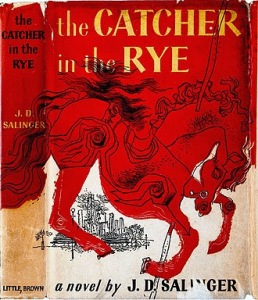From this week’s Novel Points of View Blog.
This week its Victoria Cornwall.
In January I wrote a blog post about books to read before one dies and how the list influenced a Christmas gift from a member of my family. One of the books I requested for Christmas was the classic The Catcher in the Rye, which I have just finished. The plot wasn’t what I was expecting, but perhaps that is not surprising as I knew nothing about the book beyond its cult-like status before I read it. However, its simple plot and style did make me ponder on what makes a book a classic and could I write one?

According to the Cambridge and Collins dictionaries, a “classic” is a work which is well known, of high literary standard and has lasting value. During my research the general view is that a classic should touch and connect with people, challenge a reader’s view on life, influence subsequent books and its appeal must last for years. Using it as an example or a discussion topic in book clubs and education can help with the demand lasting for years.

Armed with this knowledge, I re-examined The Catcher in the Rye by J.D.Salinger to discover why this book became a classic. The story is told from the viewpoint of a teenager and covers his thoughts and actions over a very short period in his life. The teenager becomes increasing depressed and disillusioned with the world, and although he has a kind heart, the reader can’t help feeling he is on the road to delinquency.
This novel was initially a series, but was published as a book in 1951. Now it may surprise some people, but the idea of being a teenager didn’t really emerge until mid 20th century. Prior to this children left school at a young age and went straight into work. They dressed like their parents and worked long hours like their parents. Compulsory education, coupled with the advances in technology, opened up teenagers to the wider world and its variety of new influences. Suddenly teenagers had the space to create their own culture, fashion trends and music preferences. So the arrival of The Catcher in the Rye was, in my opinion, probably one of the first novels to be from a teenage perspective, using teenage slang and… most exciting of all, the hero was suffering from all the insecurities and disillusionment that, although rife, was probably not fully acknowledged back then. Although initially written for adults, this book connected with adults and teenagers, challenged readers view of the world and subsequently changed how many books, aimed at teenagers, were written. Add the cult following it has attracted over the years, it is no wonder it became a classic.

Little Women, by Louisa May Alcott, is a coming of age tale of the March sisters. Published in two volumes in 1868 and 1869, it was later released as one volume in 1880 and became one of the most widely read novels in history. The plot had a wide appeal, as it not only connected with readers from all classes, but it resonated with readers who were, or had, navigated the choppy waters from innocent childhood to womanhood. However, the story also challenged the idea that marriage was the main goal, as the main antagonist, Jo, turns down her first marriage proposal and, instead, chooses independence and pursuing her dream of becoming a writer. This was inspirational for many readers at that time and challenged their view on life. Independent heroines, choosing who and when they marry, had been created. No wonder Little Women became a classic.

My third example of a classic is Black Beauty, by Anna Sewell. Published in 1877, it has become the best selling book of all time. The book is told in the first person (or should I say first animal) as a autobiographical memoir from the viewpoint of a working horse. It is emotional, graphic, sad, happy, and takes the reader on a roller-coaster of emotions. More importantly, it highlights the suffering of working animals in a way that had not been done before. Suddenly animals were shown to experience sadness, longing, fear and exhaustion, in a way it was not acknowledged before. This novel connected with people, as many used horses for work and transport at that time, but it also challenged their treatment and highlighted their suffering and how easily they were discarded. It became the most anti-cruelty novel of all time and was championed by animal welfare activists to further their cause. Subsequent books, told from the animals point of view or at least gave them a voice, such as Charlotte’s Webb and Watership Down, followed.
So now we know what makes a classic, all we have to do is write one. Remember, it must connect with a wide audience, challenge their view on life, influence subsequent books and remain popular for years. Hhmmm… I think that’s easier said than done!
What novel is your favourite classic? Is there a book you think should be considered a classic? Tell us about it, we would love to hear.


